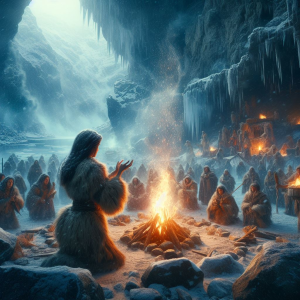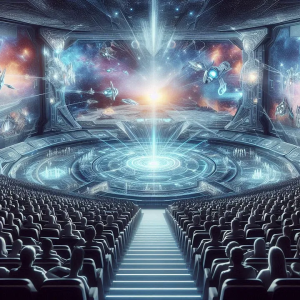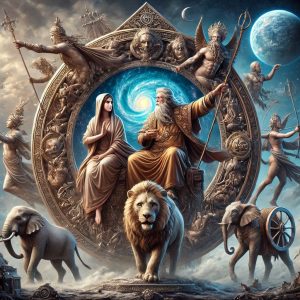
(Previous)….(Content)…..(Next)
Historical summary from myths to virtual reality
The “seven years at home” of “Science Fiction”
(Romanian)

For a kind of “acclimatization” to humans, I developed this book by dividing the evolution of “Science Fiction” into something similar to the stages of human life.
Yes, there are many “classifications” with a rather “outdated” pivotal point. I will argue this statement…
Yes, at the moment, most academic opinions describe the “Evolution of Science Fiction” as having the following stages (in a simplified “perception”, without making various correlations with the great historical events of humanity, such as Antiquity, the Middle Ages, etc.):
- Early Science Fiction, which “covers” the period between “the earliest times of human consciousness” and the “Age of Reason” (17th–18th centuries),
- Proto-Science Fiction, which “stretches” from the “Age of Reason” to the “Golden Age of Science Fiction” (late 1930s),
- Golden Age (late 1930s – late 1970s),
- The “New Wave,” which “stretches” from the “Golden Age” to “Contemporary Science Fiction” (early 1960s or 1970s, debatable, to the present).
- Contemporary Science Fiction…
Let’s begin together the long journey of arguing for another, more correct “classification”, more adapted to the true evolution of science fiction!
“Science Fiction”, as we know it today, is the result of a long evolution that has its roots in ancient times, since Antiquity, evolving in a kind of intrauterine development, including during the Middle Ages.
And, as strange as it may seem, during this period the “Seeds of the Future” developed…
From here, from this “period,” “Science Fiction” appears, which will take us on a fascinating journey through time, with many of the “stories” that we consider today to be “science fiction” having their origins in…
Ancient myths and legends, which have captivated people’s imaginations throughout the centuries, along with fairy tales and “universal stories” that have been transmitted and transcribed over time…
Passed down from generation to generation “orally,” initially rarely written, but the phenomenon of transformation into iconic became more and more widespread as the written book became more and more “present.”
“Inscriptions,” which, through a general acceptance of these times, “manifested” themselves through the ancient Mesopotamian epic of Gilgamesh (“Epic of Gilgamesh“), with the oldest versions of the text identified as being from around 2000 BC.
Which can lead to the conclusion that fantasy, like “science fiction,” can be considered exactly as old as the first recorded fiction (often considering Gilgamesh to be the first science fiction work due to its treatment of human reason and the search for immortality, “avoiding” to consider that the lack of explicit science or technology in the work has led some authors to argue that it is better classified as fantasy literature).

A kind of way of “sedimentation” of fantasies, like a confirmation through transcendence in time, but also the birth and delimitation of future literary subgenres of “Science Fiction,” or, “punctually,” of the various manifestations of the “fantasy” genre.
Thus, before Science Fiction became a recognized literary genre based on its fundamental concepts—an exploration of the unknown, cosmic travel, interaction with supernatural entities, or advanced technologies—there was a definite manifestation in the form of myths, legends, and philosophies.
Manifestations that, as we advance in time, will deepen these primitive ideas, refined and adapted according to the scientific discoveries and technological innovations of those “moments.”
Then, with the movable type printing press (“invented” by Johannes Gutenberg around 1439; however, its official use began in 1455, when Gutenberg finished his first mass-printed Bible; according to more and more opinions, a kind of first book that mixes history with… everyone can compete with what they want), human imagination began to be distributed “en masse,” with the clear and certain possibility of being able to choose their favorite genres from the overwhelmingly growing offer.
Note: In reality, movable type printing was invented in China by Bi Sheng around 1040, a printing press that used small characters printed on clay tablets, which were then fixed to a wooden or metal support. The problem of “recognition” is related only to the fact that it was used in China for about 400 years, but was not widespread outside this region. Gutenberg’s invention only improved the “printing press,” using movable metal characters, which made the printing process more efficient and flexible.
But, undeniably, this invention revolutionized book production and facilitated access to information and science, not to mention the fact that, with printing, ideas are no longer transmitted only orally or through limited manuscripts, noting that this moment is essential because it allows the birth of speculative literature and, subsequently, the first works later recognized as Science Fiction.
So, “from here,” from a “technical” point of view, begins the period of a major transition of literature from “fantasy” to “science,” because, with the birth of modern science (17th-18th centuries), we can discuss…
The Birth of “Science Fiction”: The True Birth…
This is the moment from which it can be stated, in the case of my analogy with the periods of human life, that the period of “The Seven Years at Home of Science Fiction” begins.

And, from this “point,” including during the Industrial Revolution (19th–20th century), this literary genre manifests its development or, as it is popularly said, experiences its “seven years at home” to move into the actual manifestation of childhood (which will begin around the 1950s–60s)…
Evolving from simple mythological stories to a complex literary genre that explored profound themes about human nature, technology, and the future of society.
From this “point,” we discuss the 1950s, with what is called (academically) the “Golden Age of Science Fiction,” a period in which the foundations were laid for the subsequent development of SF, which continued to diversify and adapt to the new realities of the 20th century.
But let’s not forget, it was a period in which only written literature was manifested (possibly manifested in audio; let’s remember the episode “War of the Worlds,” dramatized in audio by Orson Welles), the image making only a kind of rather insignificant entrance.
That’s why I chose the name for the 1950s as the “Golden Age of SF Books,” where there was a surge in Science Fiction subgenres and thematic expansion…
The 1960s follow another significant chapter of “Science Fiction” in which, no matter how much one comments, we witness an escape from the book written through images on the big and small screen, a period that I have called “The Consolidation of the Image through the SF Imagination.”
Yes, the “Science Fiction” type image existed long before, through graphic elements, “pulp” comics, and even in some cinematographic works. Correct!
However, look at the titles from the world of books and the titles from the world of images!
Then, in a way, I “arbitrarily” chose this “moment” because I “caught” the end of the ’60s (referring to “that ’69 of the moon landing) and, thus, the journey we will take together will also be a kind of recollection of the dreams unleashed by each new work that I avidly read…
And, it was only in the 70s that it can be said that “Science Fiction” and the subgenres that existed then (because technological progress would diversify the subgenres and even attract a return of “Fantasy” alongside “Science Fiction,” resulting in the current SF-F, quite impossible to separate in these contemporary times) manifested what it would mean (in my comparison with the human individual), with the exit from “the seven years at home” and…
There will follow a “short” period, until the 80s, which I have delimited as the childhood period of “Science Fiction,” where the image (along with the “written book”) becomes more and more visible, which will “explode” admirably in its short “adolescence” (when the world of video games appears as a new manifestation), reaching manifest “maturity” starting with the 21st century…
So, let’s begin the exploration (enough with this teaser-type introduction) to pave the way for understanding a complex cultural phenomenon, which will change its shape with technological progress and changes in society’s mentality.
Until… Through our “accumulations,” we will “reach” a maturity of the “Science Fiction” genre that we will explore until, as is normal for “Science Fiction,” we will explore the future together (with the status, I hope, of “influencer” in “Science Fiction”).
Merticaru Dorin Nicolae




